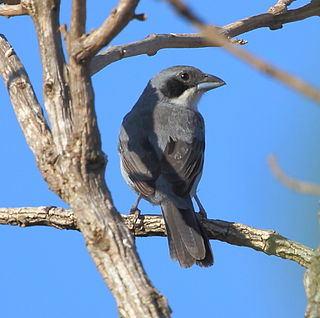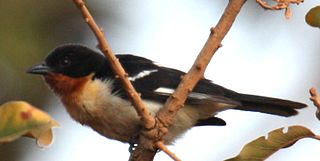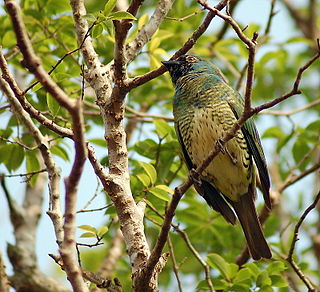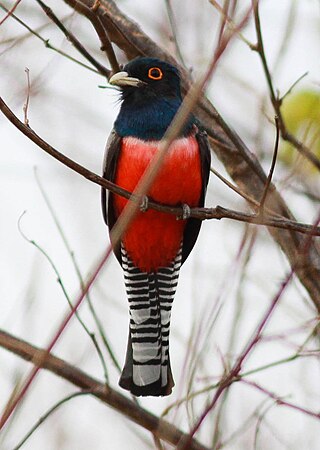
The Brazilian teal or Brazilian duck is the only duck in the genus Amazonetta. It is widely distributed in eastern South America.

The ferruginous pygmy owl is a small owl that breeds in south-central Arizona and southern Texas in the United States, south through Mexico and Central America, to South America into Brazil, Bolivia, Paraguay and Argentina.

The red-crowned ant tanager is a medium-sized passerine bird from tropical America. It is the only species now placed in the genus Habia. This species was long placed with the tanagers (Thraupidae), but it is actually closer to the cardinals (Cardinalidae).

The shrike-like tanager, also known as the white-banded tanager, is a South American bird in the tanager family Thraupidae. It is the only member of the genus Neothraupis.

The white-rumped tanager is a South American bird in the tanager family Thraupidae. It is the only member of the genus Cypsnagra.

Hemithraupis is a small genus of passerine birds in the tanager family Thraupidae found in the forests of South America.

The orange-throated tanager is a species of bird in the tanager family Thraupidae that is found very locally in humid forests around the Ecuador-Peru border. As a species it is considered threatened. The orange-throated tanager is the only member of the genus Wetmorethraupis, named after the ornithologist Alexander Wetmore. It is closely related to members of the genus Bangsia.

The swallow tanager is a species of Neotropic bird in the tanager family Thraupidae. It is the only member of the genus Tersina. It is found widely throughout South America, from eastern Panama to far northern Argentina. The species is sexually dimorphic: the female is a yellow-green and the male a turquoise blue with a small deep black face and upper throat patch.

The Caatinga puffbird is a species of bird in the family Bucconidae, the puffbirds, nunlets, and nunbirds. It is endemic to Brazil.

Touit is a genus of Neotropical parrots in the family Psittacidae.

The São Tomé green pigeon is a species of bird in the family Columbidae. It is endemic to the island of São Tomé in São Tomé and Príncipe. Its natural habitat is subtropical or tropical moist lowland forests. The species was described by Johann Friedrich Gmelin in 1789. They have disappeared from Ilhéu das Rolas due to habitat loss. There are between 37,007 and 109,255 pigeons of this species today, but this is decreasing due to unsustainable levels of hunting.

The hooded mountain tanager is a species of bird in the tanager family Thraupidae. It is the only member of the genus Buthraupis. This yellow, blue and black tanager is found in forest, woodland and shrub in the Andean highlands of Bolivia, Colombia, Ecuador, Peru, and Venezuela. At 23 centimetres (9.1 in) and 85 grams (3.0 oz), it is one of the largest tanagers.

The sooty ant tanager is a species of bird in the cardinal family (Cardinalidae). It was formerly placed with the true tanagers in the family Thraupidae and was assigned to the genus Habia with the red-crowned ant tanager.

The yellow-backed tanager is a species of bird in the family Thraupidae, the tanagers. It is found in Bolivia, Brazil, Colombia, Ecuador, French Guiana, Guyana, Peru, Suriname; also extreme eastern Panama in Central America. Its natural habitats are subtropical or tropical moist lowland forest and heavily degraded former forest.

The guira tanager is a species of bird in the family Thraupidae.

The campo troupial or campo oriole is a species of bird in the family Icteridae that is found in northeastern Brazil. At one time thought to be conspecific with the Venezuelan troupial and orange-backed troupial, it is now accepted as a separate species. It is a fairly common bird and the International Union for Conservation of Nature has rated it as a "least-concern species".

The lesser kiskadee is a species of passerine bird in the family Tyrannidae. It is the only species in the genus Philohydor. It is found in Brazil, Bermuda, Bolivia, Argentina, Colombia, Ecuador, French Guiana, Guyana, Panama, Peru, Suriname, Trinidad, Guatemala, and Venezuela. Its natural habitats are subtropical or tropical moist shrubland and swamps.

The azure-shouldered tanager is a species of bird in the tanager family, Thraupidae. Described by the French zoologist Louis Pierre Vieillot in 1817, it is only found in the Atlantic Forest of southeastern Brazil, from southeastern Bahia, eastern Minas Gerais, and Espírito Santo south to northern Rio Grande do Sul. It inhabits humid montane forests, open woodlands, secondary growth, and forest edges and can be found at elevations of up to 1,600 m (5,200 ft), but usually stays below 1,200 m (3,900 ft).

The sayaca tanager is a species of bird in the family Thraupidae, the tanagers. It is a common resident in northeastern, central, and southeastern Brazil, and Bolivia, Paraguay, Uruguay, and northeastern Argentina. A few are recorded from far southeastern Peru, but its status there is unclear, in part due to the potential of confusion with the very similar juveniles of the blue-grey tanager.

The blue-crowned trogon is a species of bird in the family Trogonidae, the quetzals and trogons. It is found in Brazil, Argentina, Bolivia, Colombia, Ecuador, Paraguay, and Peru. As with all trogons, this species is sexually dimorphic. The male has a blue head with an orange orbital ring, a red belly with a narrow white breastband and a green back. The female differs in having a grey head, a grey back and a broken white eye-ring.






















